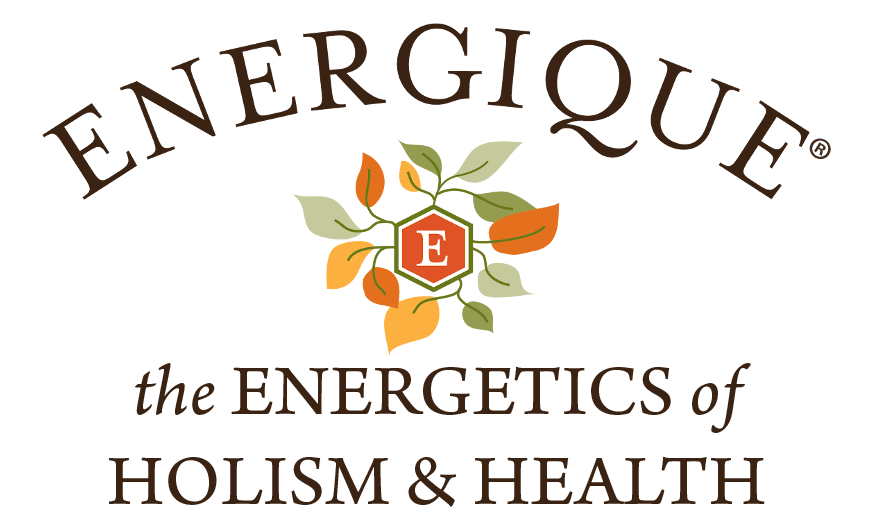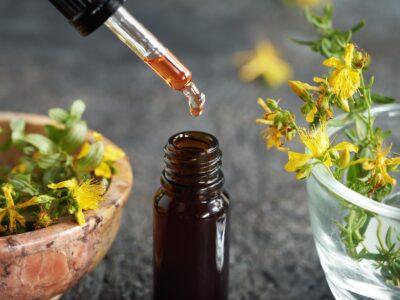For those practicing natural medicine, the month of June means an increase in summer complaints such as sports and outdoor injuries, food poisoning, allergies, burns (from outdoor grilling) and the complications of bites and stings, including Lyme disease. For those who make natural medicines, June is a time when many medicinal plants are ready for harvest, and none more so than the iconic Hypericum perforatum, St. John’s Wort, traditionally advised to be gathered on a midsummer’s day. Here at Energique, where we grow several of the medicinal herbs used to compound our homeopathic remedies, our Iowa team is preparing this month to do exactly that.

Why do we grow our own supply of Hypericum perforatum every year? While herbalists typically use the aerial parts, which are widely available on the market, it is the entire plant including the roots which has traditionally been used to prepare the homeopathic mother tincture. Additionally, growing the herb ourselves allows us greater control over factors influencing the quality of the starting material, which we believe is crucial to ensuring the quality of the resulting homeopathic remedy. Not everyone who manufactures or utilizes homeopathy thinks so, however, and some suppliers of homeopathic medicines use either stock dilutions of indeterminate origin or disdain most quality considerations when it comes to the starting materials, rationalizing these practices on the basis of homeopathy’s unique dilution method.
Given that high dilutions above 24X or 12C are unlikely to contain any molecules of the starting substance, there are some who question whether the quality of the starting substance even matters in homeopathy. Especially, this pertains to the medicinal herbs which comprise about 70% of the homeopathic materia medica. When it comes to securing quality botanicals that are rich in active constituents, factors like freshness, plant maturity, and harvest time, which matter to any herbalist, are all-too-frequently ignored by manufacturers claiming to make quality homeopathic remedies. If it’s simply going to be further diluted, one might argue, do the active constituents really matter?
Samuel Hahnmann, the originator of homeopathy, thought they did. In his Organon of Medicine, he advised that plants for homeopathic use should be tinctured in their freshest state when possible, and secured only through reputable vendors less likely to adulterate their products. He advised against using powdered herbs for this reason. Modern analytical techniques have made it possible to identify adulteration even in powdered herbs, and the US Homeopathic Pharmacopoeia provides guidance on methods to verify the identity and strength of starting plant materials.
The purpose of dilution and succussion in homeopathy is to develop the latent medicinal properties of each starting substance, which of course depends on the starting substance having medicinal properties. If the active constituents of a plant like Arnica “don’t matter” for a 30C, then how is it that two remedies such as Calc Sulph 30C and Hepar Sulph 30C, which are both primarily calcium and sulfur, have such strikingly different action when employed in high potency? It’s clear that once the molecules are gone, the water retains an imprint of even slight differences in the substance used to prepare the remedy. The quality of the dilution owes much to the quality of the starting material itself.
Even beyond this, homeopathy is an energetic medicine and so the intention put into the preparation of remedies is likely to be even more important, not less. The care that goes into selecting, preparing, and at Energique also the planting, cultivation and harvesting of medicinal plants is considered an important contributor to the overall quality of the resulting remedies. In the case of Hypericum perforatum, the St. John’s Wort grown on-site will be harvested with most of the plants in the budding stage, just beginning to flower. St. John’s Wort’s primary active constituent, hypericin, is most concentrated in the flower buds and begins to deteriorate as the flowers age. Hypericin is believed to be responsible both for the herb’s anti-depressant effects, for which it is not typically used in homeopathy, and its ability to relieve neuralgic pain, for which it is famous in homeopathy and one of the best remedies. While the oil of the leaf applied topically can relieve nerve pain, these same medicinal powers developed through homeopathic potentization have been credited with far more dramatic cures, even administered as a single pellet under the tongue. Hypericum has been credited with curing tetanus and reflex sympathetic dystrophy syndrome in the homeopathic literature*, and while it is implausible that any molecules of hypericin were administered through the remedy, its presence in the remedies’ initial dilutions is likely crucial to its potentized effect.
In addition to factors like plant part, harvesting stage, and storage conditions, the season and atmosphere of a plant’s harvesting can affect its concentration of active constituents. Even the time of day may be important, and traditional herbalists put great stock in astrological conjunctions, like the exaltation of ruling planets they presumed to govern an herb’s medicinal properties and use. St. John’s Wort was steeped in lore of this kind, to an even further extent than most other herbs appearing in ancient compendia like John Gerard’s 1633 ‘Herball,’ which claims its medicinal virtues to fall under the ruling influence of the sun (at that time still thought to be a planet).
St. John’s Wort’s modern name was chosen in honor of St. John the Baptist, whose feast day in the Christian calendar was chosen to coincide with the summer solstice. This day, the longest day and shortest night of the year, was when the sun’s power over things on earth was thought to be at its height, and it is likely this day was chosen by the early Church in an effort to Christianize pagan sun-worship. The ancient Greeks considered St. John’s Wort to be sacred to the sun god Apollo, and most ancient traditions advise it should be gathered at midday on the summer solstice, to maximize its presumed magical properties.
Does any of this lore still matter today? Hypericin has a unique relationship to ultraviolet rays, and has been proven responsible for the notorious photosensitizing effect that large doses of St. John’s Wort extract can provoke as a side effect. It has also been shown that the plant produces hypericin in direct response to sunlight, possibly as an adaptive mechanism to protect its reproductive structures, meaning the plant would actually be most potent whenever sunlight is most intense. Because of the way the earth’s seasonal tilt affects the UV index, all things being equal, one actually is most likely to get a sunburn at noon on the summer solstice, though in reality factors like cloud cover and varying ozone concentrations can thwart the timing of this effect.
In reality it is likely not necessary to gather St. John’s Wort at noon on a midsummer’s day, at least not for the sake of its medicinal properties. Rather, effort should be made to gather the plant when it is just beginning to flower, which occurs in mid to late June, around noon on a day with full sun, i.e. not overcast. In terms of maximizing the plant’s hypericin content, its freshness and the efficiency of processing are likely to matter more than gathering it at any exact date and time. The most important considerations for us at Energique will be harvesting our plants when many are just beginning to flower, to maximize the number of hypericin-rich buds, and to time collection for a sunny day in mid-June. Not only will this improve the constituents in the plant, but collection during dry weather will help to ensure that the harvested material does not exceed the microbial limits set by modern quality standards.
Growing our own plants on-site to prepare homeopathic remedies from soil to bottle is just one of the steps we take to promote homeopathy and ensure the quality of our products. From procuring exotic snake venoms to resurrecting materials unique to homeopathy, like preparing Hepar Sulphuris Calcareum from Hahnemann’s original method, we at Energique hope that our commitment to quality and raw material traceability will ensure these medicinal substances remain available to healers for generations to come. Respect for tradition combined with modern quality standards is the reason so many practitioners obtain great results from our products.
*These claims are from the traditional homeopathic literature and have not been reviewed by the FDA.


 Beyond Probiotics: Keys to Support Healthy Digestion
Beyond Probiotics: Keys to Support Healthy Digestion